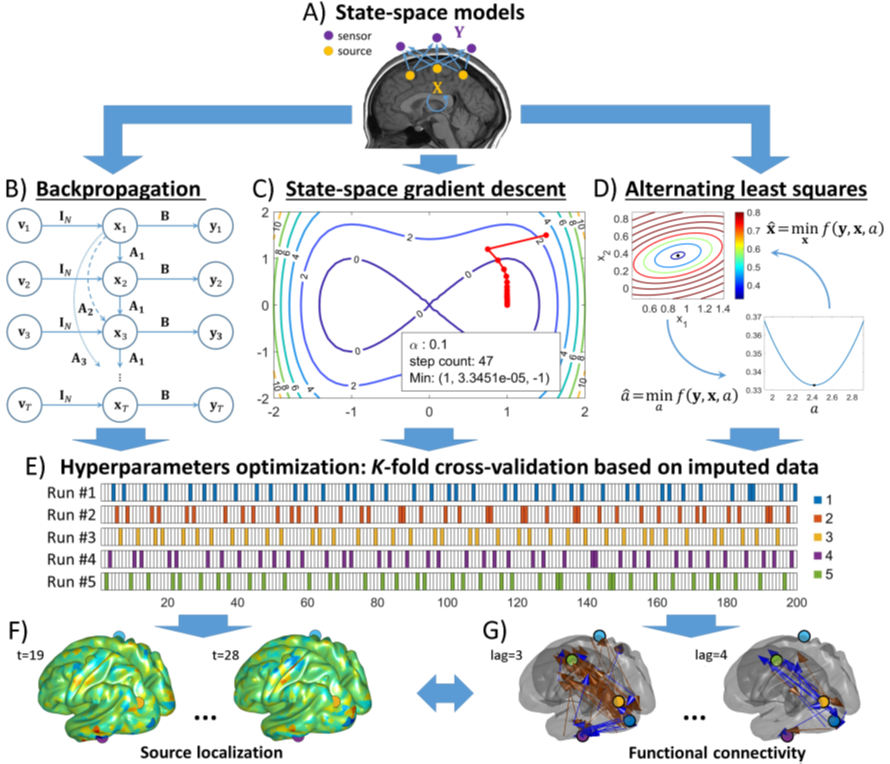Solving brain source localization and functional connectivity problems
The brain and universe are the most clearly significant scientific barriers. For example, an estimated 6.7 million USA citizens older than 65 years are living with Alzheimer’s in the present without cure, and many more humans live with some type of brain disorder. The current research aims to improve the state-of-the-art for mapping the brain source activity and functional connectivity, which are at the core for understanding how brains process and organize the information necessary for daily life functions. Moreover, improved understanding of the brain machinery may also be essential for the development and control of artificial intelligence algorithms.
This research addressed the limitations of current state-space models and algorithms to small-scale data analysis, which make them less useful to understanding the brain information processing phenomenon. Notice that state space models are very helpful to model hidden dynamics which can be observed only through measured data, and thus this methodology may help to improve our understanding about the “black box” which is the brain machinery in our current state of knowledge. The current project addresses the above challenges by proposing and estimating state-space models in large-scale dimensions using a novel data-driven regularization framework as shown in the figure below (computational pipeline).

Figure 1: State-space models applied to the estimation of brain source localization and functional connectivity problems (A). Three different algorithms were implemented and tested with simulated and real data (B-D), for a generalization of state-space models using a regularization framework based on a novel cross-validation method to estimate hyperparameters (E). The main outcome from this pipeline is the simultaneous estimation of brain source activity (F) and their functional connectivity maps (G).
Due to the intensive computation and large RAM resource demand, this research was only possible with the use of the Northern Ireland High Performance Computing (NIHPC) cluster resources. In particular, three algorithms were implemented to solve state-space models: state-space’s backpropagation (SSBP), gradient descent (SSGD) and alternating least squares (SSALS). The SSALS algorithm was particularly helpful to estimate the brain source localization and functional connectivity problems simultaneously for thousands of sources in the brain cortical surface, due to its stability and much faster convergence in large dimensions. Even though, the initial implementation based on CUDA programming (using cuBLAS, cuSPARSE and cuSOLVER) took about 30 hours to solve these problems on the NIHPC’s V100 GPU devices. However, a more recent version of SSALS algorithm was implemented exclusively by relying on CPU-cores computations, realizing that the standard Matlab sparse left-division matrix operation was slightly faster and less resource demanding than the GPU-based implementation. This last implementation took about 20 hours but relying on 17-cores and about 0.7 terabytes of RAM to perform comparable calculations.
Contact information:
Jose Sanchez Bornot: jm.sanchez-bornot@ulster.ac.uk
Acknowledgements:
The authors are grateful for access to the Tier 2 High-Performance Computing resources provided by the Northern Ireland High Performance Computing (NI-HPC) facility funded by the UK Engineering and Physical Sciences Research Council (EPSRC), Grant No. EP/T022175/1. Damien Coyle is supported by a UKRI Turing AI Fellowship 2021-2025, funded by the EPSRC, Grant No, EP/V025724/1. Roberto C. Sotero was partially supported by grant RGPIN-2022-03042 from the Natural Sciences and Engineering Research Council of Canada. J. A. Scott Kelso research is supported by the Florica Atlantic University Foundation.
References:
[1] Sanchez-Bornot, J. M., Sotero, R. C., Kelso, S., & Coyle, D. (2022). Solving large-scale MEG/EEG source localization and functional connectivity problems simultaneously using state-space models. arXiv preprint arXiv:2208.12854.
[2] Sanchez-Bornot, J. M., Sotero, R. C., & Coyle, D. (2023). Dynamic source localization and functional connectivity estimation with state-space models: preliminary feasibility analysis. ICASSP 2023.
